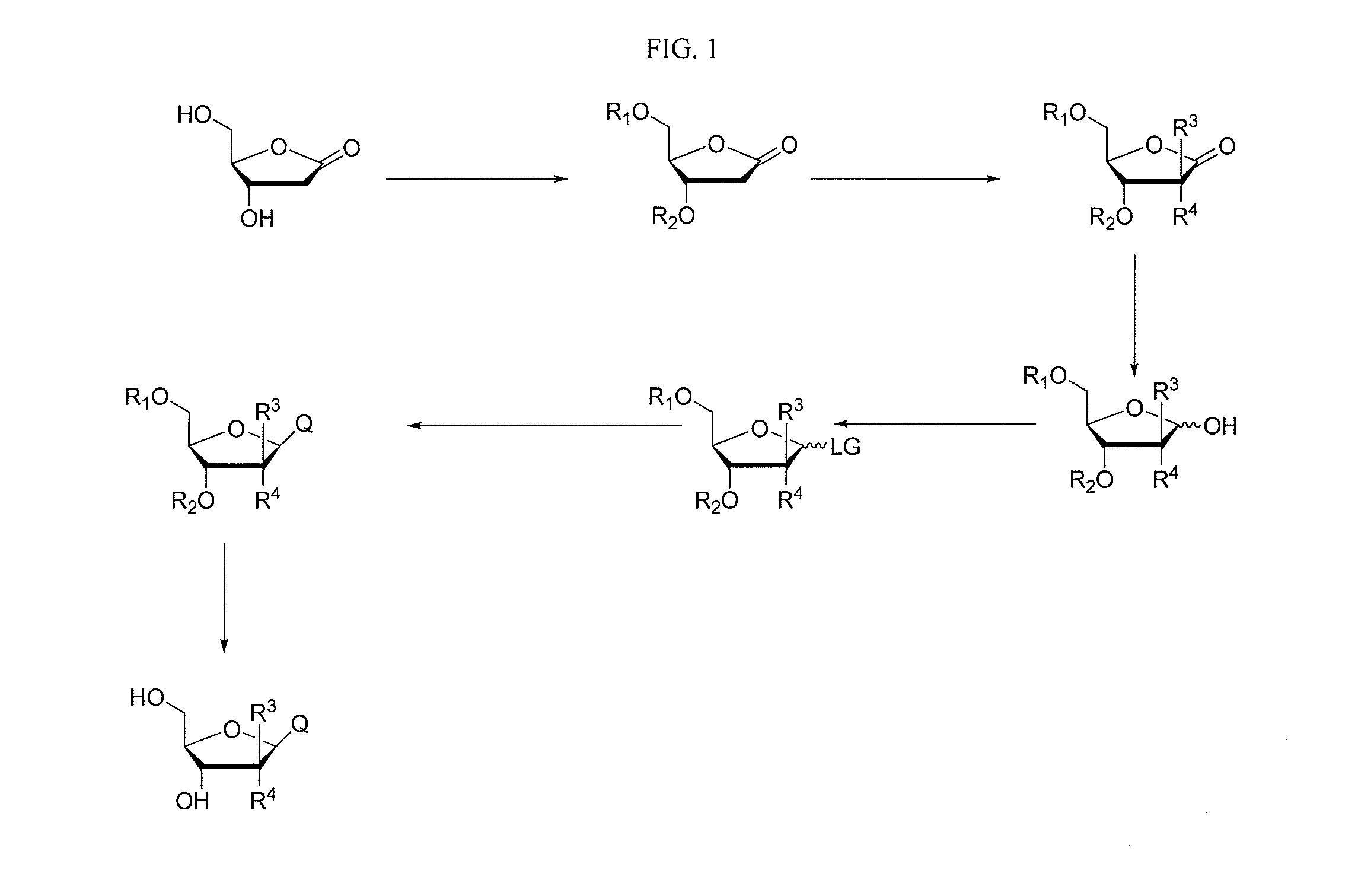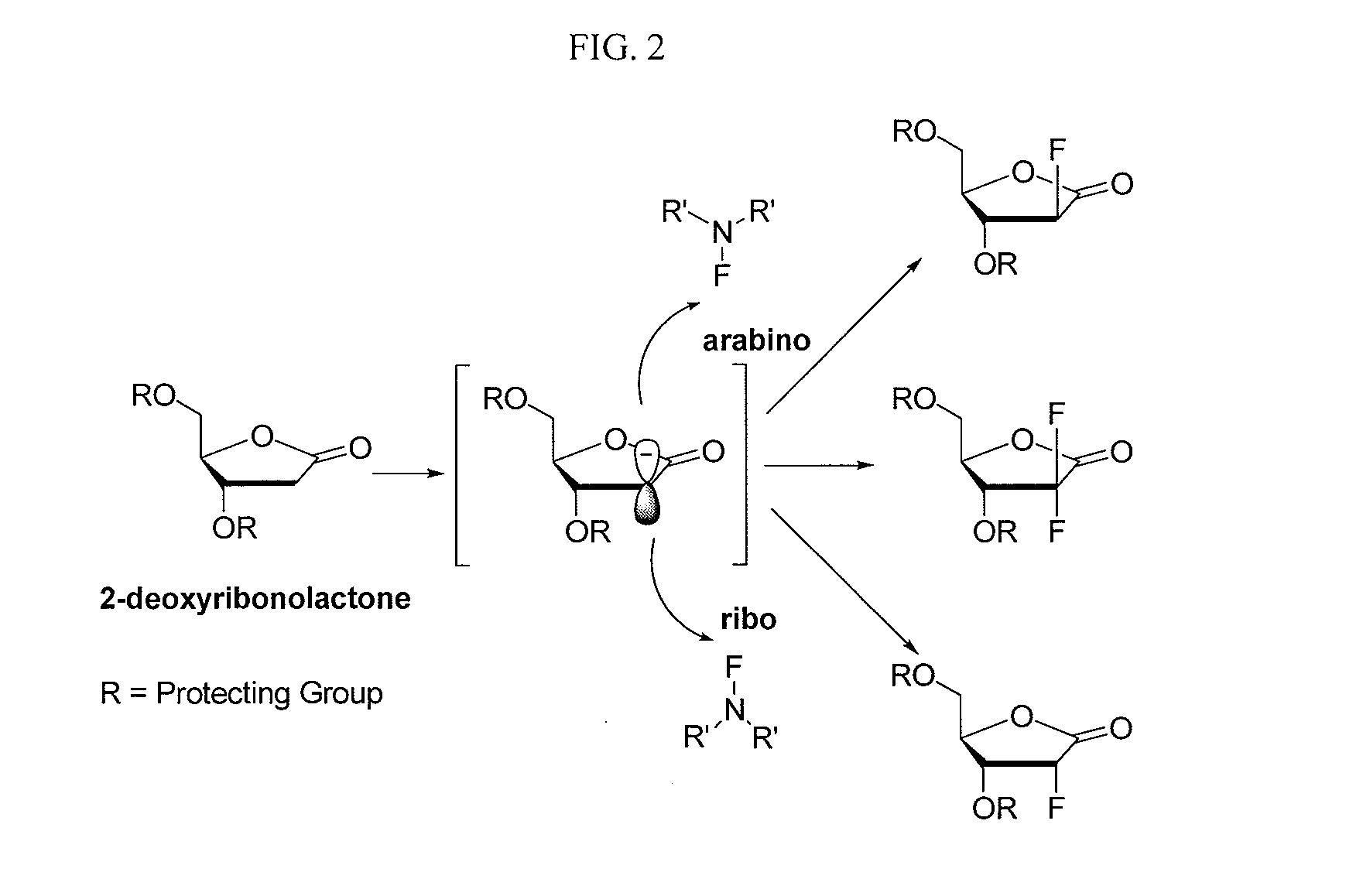2-fluorinated riboses and arabinoses and methods of use and synthesis
a technology of arabinose and ribose, which is applied in the field of 2fluorinated ribose and arabinose and methods of use and synthesis, can solve the problems of no concise or efficient synthesis of 2-deoxy-2-fluoro-ribofuranose, 8 steps in the method, and low overall yield (15%)
- Summary
- Abstract
- Description
- Claims
- Application Information
AI Technical Summary
Benefits of technology
Problems solved by technology
Method used
Image
Examples
example 1
[0279]2-deoxy-3,5-di-O-(p-chlorobenzoyl)-D-ribonolactone (5). A solution of methyl-2-deoxy-3,5-di-O-(p-chlorobenzoyl)-D-ribofuranoside (500 mg, 1.18 mmol) in 20 mL of 80% acetic acid aqueous solution and 2 mL of 10% aqueous HCl was heated to reflux for an hour and then cooled to room temperature. Water was added, organic phase was washed with water, saturated NaHCO3 solution, brine and dried over anhydrous Na2SO4. Solvent was removed under vacuo and crude product was dissolved in 10 mL of CH2Cl2, to this solution was added PCC (294 mg, 1.36 mmol). Reaction was stirred at room temperature and monitored by TLC, once it was completed, PCC was filtered off, filtrate was concentrated and purified by column chromatography (hexanes:ethyl acetate 4:1) to afford 5 (190 mg, 0.46 mmol, 40% yield for two steps) as white solid. mp=89-90° C. 1H NMR (CDCl3, 400 MHz), δ ppm: 2.81 (dd, J=2.1, 18.8 Hz, 1H), 3.12 (dd, J=7.5, 18.9 Hz, 1H), 4.60 (dd, J=3.7, 12.3 Hz, 1H), 4.68 (dd, J=3.8, 12.3 Hz, 1H), 4...
example 2
[0280](S)-4-hydroxymethyl-2-buten-4-olide (6). To a flame-dried round-bottom flask were added 5 (155 mg, 0.38 mmol) and NFSi (120 mg, 0.38 mmol) in 5 mL of anhydrous THF. The solution was cooled to −78° C. and LiHMDS in THF solution (0.456 mL, 0.456 mmol) was added dropwise. Reaction mixture was allowed to stir at −78° C. for additional hour and then quenched by saturated NH4Cl solution. Organic layer was washed by saturated NaHCO3 solution, water, brine and dried over anhydrous Na2SO4. Column chromatography (hexanes:ethyl acetate 4:1˜2:1) gave 6 (62 mg, 0.24 mmol, 65%) as white solid. mp=115-116° C. 1H NMR (CDCl3, 400 MHz), δ ppm: 4.55 (dd, J=4.8, 12.0 Hz, 1H), 4.61 (dd, J=3.7, 12.1 Hz, 1H), 5.34 (m, 1H), 6.22 (dd, J=2.1, 5.8 Hz, 1H), 7.40 (d, J=8.6 Hz, 2H), 7.48 (dd, J=1.5, 5.7 Hz, 1H), 7.91 (d, J=8.6 Hz, 2H). 13C NMR (125 MHz, CDCl3), δ ppm: 63.1, 76.9, 80.8, 123.6, 127.5, 128.91, 128.96, 131.1, 131.6, 140.2, 152.1, 165.2, 172.1. HRMS (ESI): calcd. for C12H9ClO4: 252.0189. Found:...
example 3
[0281]2-deoxy-3,5-di-O-(t-butyldimethylsilyl)-D-ribonolactone (7). To a solution of 2-deoxy-D-ribose (1.0 g, 7.45 mmol) in 6 mL of water was added Br2 (2 mL). The flask was sealed and the content was stirred at room temperature for 5 days. The resulting mixture was neutralized by adding silver carbonate until the pH was 7. The mixture was filtered and the filtrate was concentrated under reduced pressure to yield 2-deoxyribonolactone as a yellow oil. Without further purification, the crude product was dissolved in 20 mL of anhydrous DMF, and imidazole (2.53 g, 37.3 mmol) and t-butyldimethylsilyl chloride (4.5 g, 29.8 mmol) were added. The resulting solution was stirred at room temperature for 24 h, and quenched by addition of water. Water layer was extracted by ethyl acetate (3×10 mL), organic layers were combined, washed with brine and dried over anhydrous Na2SO4. Crude product was concentrated in vacuo. Flash chromatography (hexanes:ethyl acetate 20:1) afforded 7 (3.2 g, 8.9 mmol, ...
PUM
| Property | Measurement | Unit |
|---|---|---|
| pKa | aaaaa | aaaaa |
| body weight | aaaaa | aaaaa |
| body weight | aaaaa | aaaaa |
Abstract
Description
Claims
Application Information
 Login to View More
Login to View More - R&D
- Intellectual Property
- Life Sciences
- Materials
- Tech Scout
- Unparalleled Data Quality
- Higher Quality Content
- 60% Fewer Hallucinations
Browse by: Latest US Patents, China's latest patents, Technical Efficacy Thesaurus, Application Domain, Technology Topic, Popular Technical Reports.
© 2025 PatSnap. All rights reserved.Legal|Privacy policy|Modern Slavery Act Transparency Statement|Sitemap|About US| Contact US: help@patsnap.com



